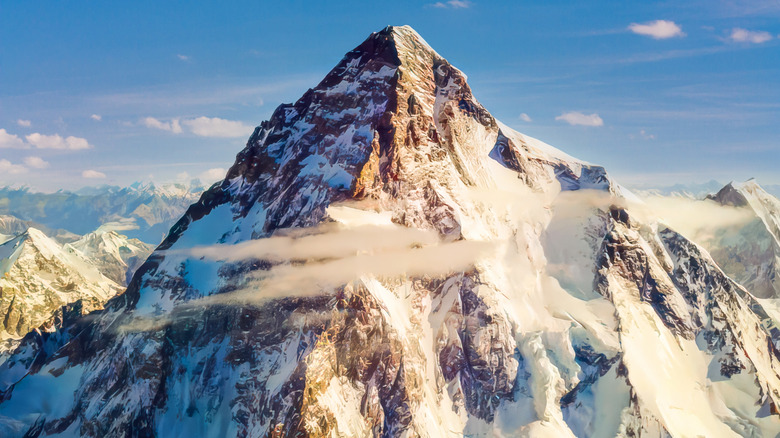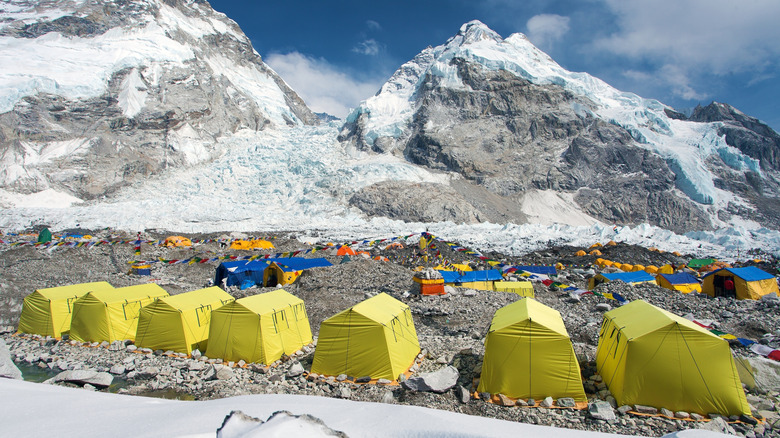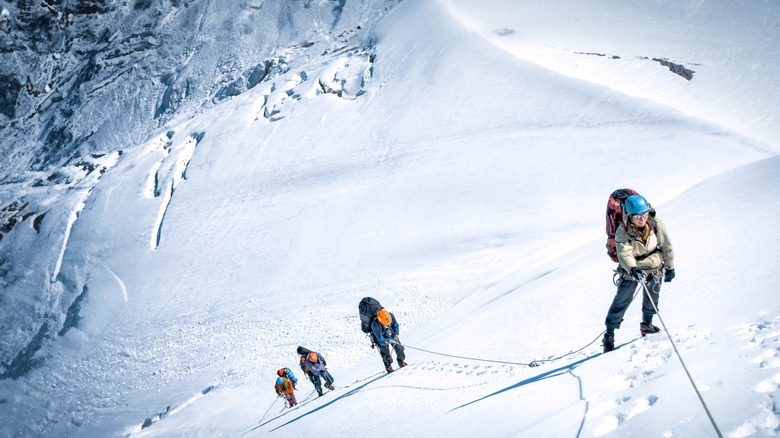Everest May Be The World's Tallest Peak, But This 'Savage Mountain' Is The Hardest To Climb
For avid mountaineers, Everest has long been one of those ultimate bucket-list travel destinations. Located on the border of Nepal and Tibet, this Himalayan beauty sits at 29,032 feet above sea level — just a few thousand feet below the average cruising altitude of most commercial planes. Of course, this is just an estimate — one of the interesting facts you might not know about Mt. Everest is that it's actually growing taller every year.
One of the mountain's best-known facts, though, is the deadly risk involved in attempting the summit. Journalist Jon Krakauer famously chronicled the events of the notorious 1996 Everest disaster in his best-selling book, "Into Thin Air," where a treacherous storm claimed the lives of eight. While this incident was the worst loss of life to occur in a single day, it wasn't an anomaly: More than 300 souls have perished up here. Nevertheless, summiting Everest continues to be a highly sought-after goal. But is it the hardest to climb? Actually, experts say no. Surprisingly, relative to attempts, there have been more successful ascents of Everest than of K2, the runner-up in the height contest. This imposing summit, nicknamed "Savage Mountain," is exactly that — a killer peak with a vertiginous incline and extraordinarily difficult terrain.
Intersecting the borders of China and Pakistan, the world's second-highest mountain soars above the clouds at 28,251 feet (just shy of 800 feet shorter than Everest). It's part of the Karakoram Mountain range, where you'll find the unspoiled trekking region of Nangma Valley, the "Yosemite of Pakistan." But although it's smaller and less attempted, don't be fooled: K2 is a monster of a mountain with an alarming fatality rate that's both more technically challenging and deadlier than its Nepalese counterpart.
The technical challenges of K2 versus Everest
K2 is considered a harder climb due to the high level of technical proficiency required to ascend it. Everest's accessibility and the skill of the guides who lead the expeditions mean that a mountaineering neophyte with decent fitness (and around $45,000 in the bank — the permit alone costs $15,000 per person) could make a summit attempt. Only a few main sections of Everest, including Khumbu Icefall and Hillary Step, require technical climbing. And overall, this mountain has a much less steep average incline — there are even some relatively flat plateaus, where climbers can rest and recover.
This is not at all the case with K2, where summiters need to have an extremely high level of fitness and a great deal of experience in both mountain and ice climbing. K2 is one incessant slog upwards. Its slopes have a vertigo-inducing, precipitous gradient, averaging about 45 degrees with some at 60 degrees. And the risk of falling rocks and avalanches, while a concern on both peaks, is more prevalent on K2. Its nearly-vertical slopes are often completely covered in snow, and there are several insecure rocky sections. Safety and tech equipment, including helmets, ice axes, and crampons, are absolutely mandatory throughout the entire climb, whereas on Everest, many choose to scrap their helmets, putting them on only for the tricky Khumbu Icefall section.
Importantly, though, the rules regarding Everest have been updated by Nepal's Department of Tourism to discourage beginners from accessing the world's highest peak. Potential climbers are now required to have at least one previous (and proven) experience climbing a 7,000-meter (22,965 feet) summit in Nepal. Travel insurance and a Nepal government-approved medical certificate are both mandatory. And for every two trekkers, expeditions must hire at least one Sherpa or certified guide.
Why K2 is deadlier than Everest
Despite improvements in climbing operations and more stringent requirements for summiters, the environmental factors are no joke on either peak and can lead to injuries and fatalities. Everest's unforgiving weather consistently puts mountaineers in danger. But K2's conditions are significantly more treacherous. It's much farther north than Everest, with relentless winds, spontaneous blizzards, and colder temperatures (lows of -65 versus -40 degrees Fahrenheit). As a result, hypothermia and frostbite are higher risks here. Additionally, Everest has more safety measures in place. The commercialization of the world's tallest mountain, with all its downsides, means that there is better infrastructure. The routes are well-established, with fixed ropes and ladders set up in advance. And helicopters are readily available for emergencies, flying in from villages about 10 miles away.
Most importantly, though, is the presence of thousands of Sherpas within the expedition teams, who guide and care for clients. This Nepalese ethnic group has adapted to high-altitude conditions, having lived in the Himalayas for the past 6,000 years, making them extremely adept mountaineers. On the other hand, K2 has fewer guides and less safety infrastructure — and helicopters need to fly in from a Pakistani city 80 miles away, making responses to emergencies much slower.
As of 2025, there have been 11,346 summits of Everest, while 311 people have died (via Climbing). In comparison, K2 has a much higher death-to-summit ratio, taking 96 lives and producing just over 800 successful summits. The fatality rate is currently around 13%, compared to Everest's 3%, making it one of the world's deadliest mountains. Although K2 is certainly more difficult to climb, both mountains are physically demanding and present serious risks. The decision to attempt either one should not be taken lightly.


